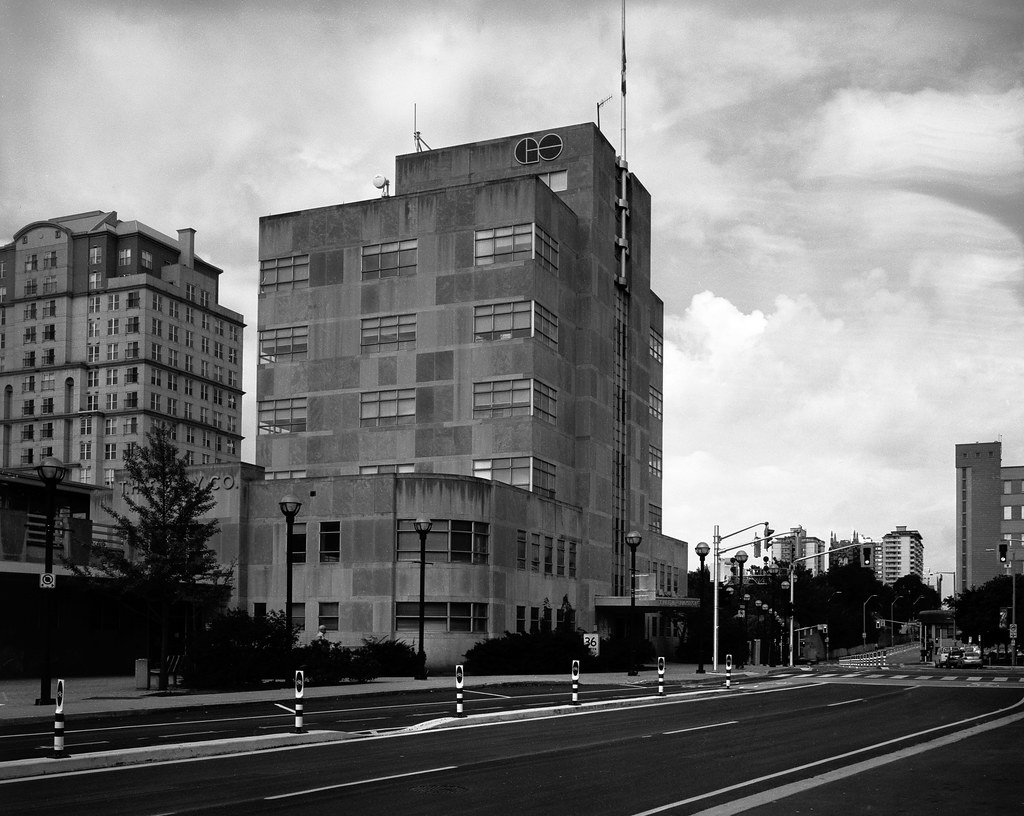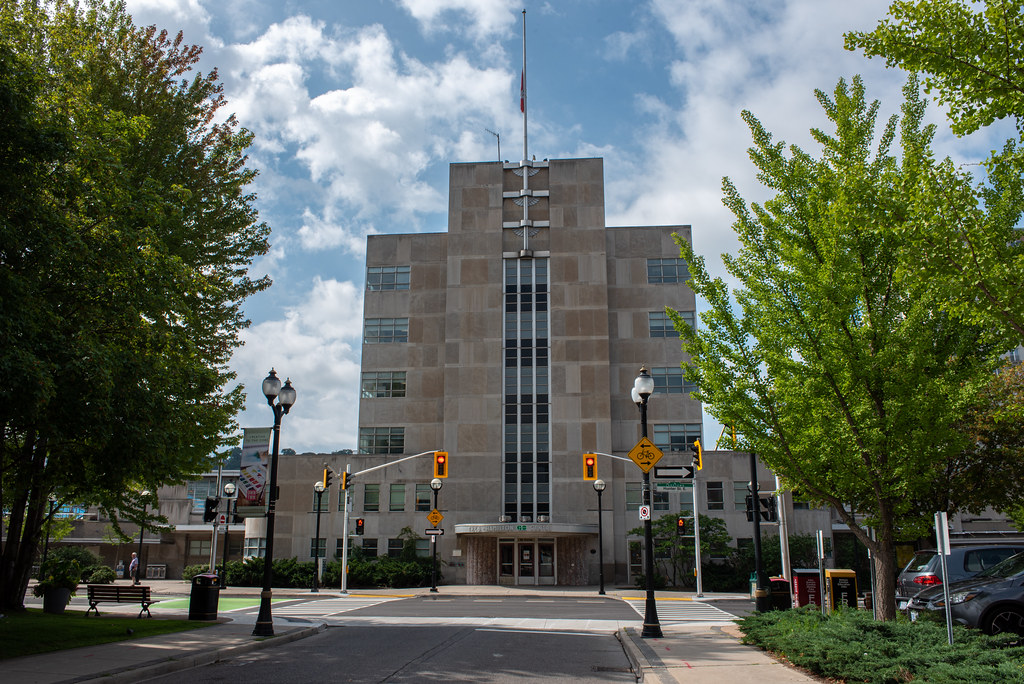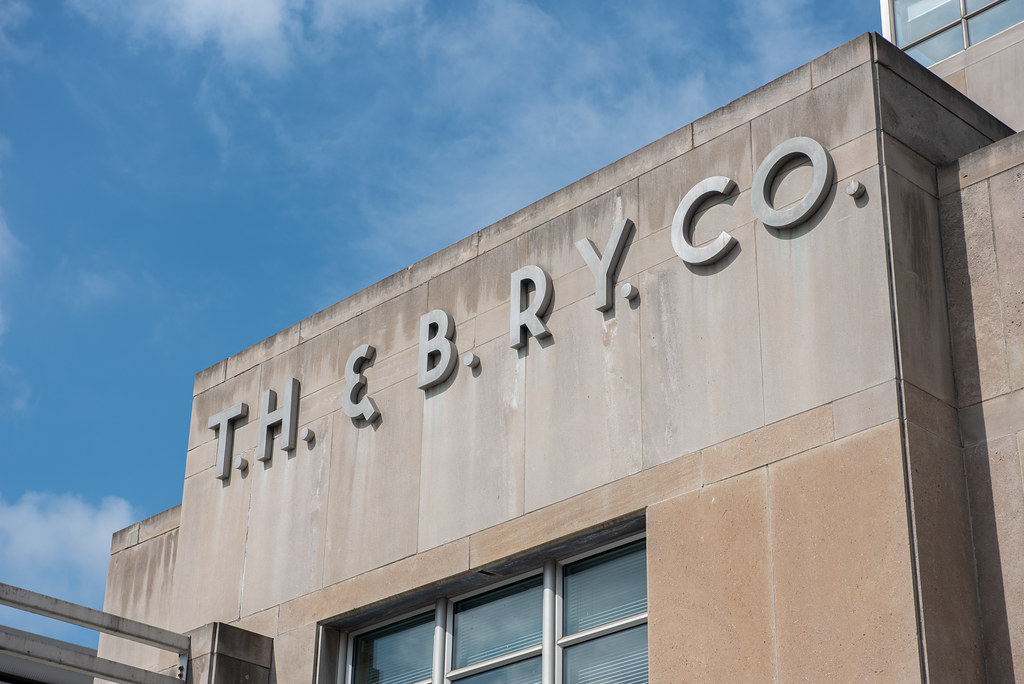If you look up the definition of Art Deco and Streamline Moderne, you will probably see a photo of the Hamilton GO Centre. Clean lines, steel and limestone, glass, and a typeface speak to the future view of the 1930s. The GO Centre is the station that inspired my love of art deco and the look and feels of the graphics for this project, especially the font choice.

Graflex Crown Graphic – Fuji Fujinon-W 1:5.6/125 – Ilford HP5+ @ ASA-200 – Pyrocat-HD (1+1+100) 9:00 @ 20C
For almost the entire time that the city of Hamilton has had rail service, most services were outside the city’s downtown core. First with the Great Western Railway and then later Grand Trunk. Despite being the biggest operator in Ontario, Grand Trunk always did whatever it wanted with little recourse from the communities it served. And in many cases, smaller operators got their start because businesses and people demanded improved service or at least some level of choice. The Toronto, Hamilton & Buffalo Railway fits right into that category. While the original charter proved far too restrictive to allow any work to be completed, a recharter and reinvestment saw actual progress, and a line between Brantford and Welland was built. The New York Central and Canadian Pacific purchased control of the company but allowed it to operate independently. Regarding station structures, most were simple wooden buildings following Victorian station styles. In urban cities, larger brick stations were constructed, but it was decided that the station would be a grand affair for Hamilton. Walter Stewart of William Stewart & Sons would be the chief architect on the project and drew up a Gothic Revival three-storey station for Hamilton downtown. Toronto, Hamilton & Buffalo secured a large block at the intersection of James and Hunter to construct their new station and headquarters, located right along the street-level tracks. The land already occupied by the Salvation Army and several private homes was purchased and knocked down ahead of the construction in June 1895. The goal is to have the new station opened by August. A stonemasons’ strike over unpaid wages halted any construction work for several months. Sadly how the strike ended up being resolved is unknown, but there is a sad chance it involved violence and militia activity. The new station opened in December 1895. The three-storey structure featured a four-storey tower on the southwest corner. The first floor contained several large waiting rooms, a ticket concourse, several storefronts to purchase newspapers, shoe shining and a lunch counter. The second floor held traffic operations and other station offices, while the railway executives occupied the third floor. The line became rather popular, and by 1900 the station welcomed twenty-six daily trains. And despite efforts to coordinate train and street traffic, accidents did happen. The city did try in 1910 to get the right-of-way rerouted and looked towards Grand Trunk for help, but Grand Trunk refused, as did the Federal Government.

Nikon D750 – AF-S Nikkor 28-70mm 1:2.8D
Nikon D750 – AF-S Nikkor 28-70mm 1:2.8D
In 1913, Toronto, Hamilton & Buffalo began to elevate their train line through downtown Hamilton. But between troubles with the city and the arrival of World War One, the entire project remained in limbo. In addition to elevating their tracks, the operator purchased the land on the other side of Hunter Street to build a new station to meet the expanded demands. The railway and the city fought for nearly a decade before reaching an agreement. Under a 1930 agreement, the city would close several streets to allow rail bridges to run over the top and the roads to run underneath. Work on this started in 1931, as Toronto, Hamilton & Buffalo began to design a new station. For this, they hired the New York architectural firm Fellheiner & Wagner. They presented a grand future vision with a streamlined modern art deco structure, with a ten-storey office tower, several platforms and even an underground mall. And the city liked what they saw, but railway executives did not, and the entire project ended up being scaled back. The office tower was reduced to seven storeys, the number of platforms to one, and the underground sections eliminated. When the city pushed back, the option to add additional floors was put on the table, and a rich limestone exterior with steel and glass was added to the surface. Construction on the new station started in December 1932 and moved quickly; the steel skeleton rose, and soon, the exterior features were beginning to be added. The interior featured a large open concourse and waiting area, birch wood panelling, bright modern lighting, windows, and steel accents. Corners were turned into curves. The second-floor mezzanine featured a state-of-the-art central traffic controller that could operate and track tracks across the entire Toronto, Hamilton and Buffalo lines. The station opened with great fanfare in June 1933. Executives and railways operations moved to the new station’s tower; even the offices were well-appointed. The station enjoyed a great deal of traffic through the war years and into the mid-century. But the 1960s brought a more significant decline; while passenger service moved to a more commuter model, Dayliners from Canadian Pacific were frequent callers; one even ran from Toronto to Buffalo daily. With the introduction of GO Transit in 1967, the Dayliner would be the only caller at the station. In 1976, after a decade of financial turmoil among American rail operators, Canadian Pacific took complete control of Toronto, Hamilton & Buffalo and began to wind down services at the Hamilton Station. There were brief discussions about using the station for a new light-rail system from GO in 1982, but nothing came from those. Instead, Canadian Pacific began to move operations to Toronto, with the last train coming through in 1981 and the Central Traffic Control system shutting down for good in 1990.

Nikon D750 – AF-S Nikkor 28-70mm 1:2.8D
Sony a6000 – Sony E PZ 16-50mm 1:3.5-5.6 OSS
Rather than see the station demolished, the Federal Government granted protected heritage status as an example of streamlined modern not seen in many other stations in Canada. While never officially closed, the station remained under lock and key for three years before GO Transit began operating out of the platforms in 1993, moving from the old Canadian National Station. The move stirred up panic at the Ontario Legislature. Still, eventually, a multi-million dollar transit improvement system package passed with a great deal of money earmarked for restoration efforts to the Hunter Street station. Despite years of neglect, Canadian Pacific had abandoned the station in place, but a lot needed to be done. The exterior was cleaned up; the original signage was repaired and replaced. The interior concourse and station were spruced up; new commercial spaces were installed, and general repair and restoration were done. The new Hamilton GO Centre opened in July 1996 and provided a downtown transit hub for trains and buses. The station retains most of its original style and design. The most significant part is the second-floor mezzanine, a small museum dedicated to Toronto, Hamilton & Buffalo found a home there. And their most significant piece, the original traffic controller, was left behind. While the museum is not always open, checking out at a Doors Open Event or by appointment is worthwhile. Sadly the condition of the office tower remains unknown and close to the general public. Today the station remains a vital part of interurban transit in Ontario and, paired with West Harbour, is set to welcome all-day GO service to Hamilton.

Nikon D750 – AF-S Nikkor 28-70mm 1:2.8D